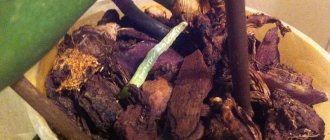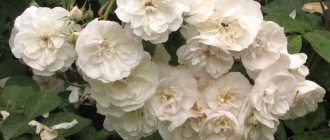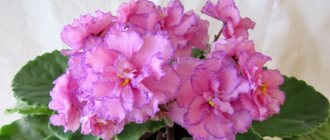Coleus is a plant of the Lamiaceae family; people also call it “nettle” because of its external similarity. The leaves are heart-shaped and vary in color; they can combine several shades at the same time: green, burgundy, yellow, red. There are a large number of its varieties (more than 1000), the most common are Blume, Black Dragon, Hybrid, Wizard. When purchasing a plant in a store, you need to pay attention to the presence of shoots, there must be more than one, as well as the absence of a flower, otherwise problems may arise in their maintenance.
Conditions for growing coleus at home
The table shows the basic requirements necessary for flower growth.
| Indicators | Description |
| Lighting | Avoid direct sunlight; in summer it is better to take it outside (balcony). |
| Optimal temperature | In summer +18 °C, in winter +12 °C. |
| Watering | Spring-autumn - abundant, lukewarm water, while it is necessary to control the dryness of the top layer in the pot. In winter – moderate, do not allow the soil to dry out. |
| Humidity | High, constant spraying of leaves is required. In winter, the ideal place for the plant is the kitchen, where conditions are best during this period. |
| Priming | Unpretentious, any soil mixture will do; minerals are added as needed. |
With a lack of light, the plant begins to grow rapidly upward and lose foliage, and its excess leads to stunting and loss of color saturation. Therefore, it is very important to ensure that the light is supplied correctly. The temperature regime is also important - the flower reacts very sharply to its changes. The nitrogen content in the soil helps to increase color saturation.
You can increase the humidity by placing a reservoir filled with wet expanded clay next to the pot.
Interesting varieties
In cultivation there are varieties often designated as Coleus × hybridus. One can write endlessly about the beauty of these plants, as new varieties are constantly appearing, with original, colorful leaves.
The most attractive are variegated varieties, green-yellow-carmine, pink-green, salmon-pink, brownish-red with yellow edging, beet with green spots.
There are many cultivars on the market bred for specific characteristics - size or pattern, leaf color - from light green to various shades of pink, burgundy, purple to dark, almost black (for example, Coleus Dark Star).
The patterns on the leaves come in a whole range of shades of yellow, and can also be white.
- "Electric Lime" Electric Lime - light green leaves with a lemon vein;
- "Florida Sun Rose" Florida Sun Rose - green-pink-purple leaves;
- "Gatar Glory" Gatar Glory - yellow-orange leaves;
- “Pink Chaos” Pink Chaos – green-white-pink leaves;
- “Splish splash” Splish Splash – green-burgundy leaves;
- "Wasabi" Wasabi – green leaves;
- "Bronze Age" Bronze Age - with copper-round leaves, compact shape;
- "Caipirinha" Caipirinha - with lemon leaves, burgundy vein;
- "Golden Dreams" Golden Dreams - lemon leaves with a red vein;
- “Pineapple Splash” Pineapple Splash – lemon leaves with burgundy spots;
- "Sky Fire" Sky Fire - with velvety, burgundy leaves with a bright green edge;
- “Walter Turner” Walter Turner – burgundy-red-green;
- Wizard Scarlet - purple with light green border;
- "Battemilk" Buttermilk - jagged, yellow-green leaves;
- “Religious Rutabaga” Religious Rutabaga – variegated, purple-green-cream;
- “Timotei” Timotei – creamy green;
- "Melibu Apricot" Malibu Apricot - apricot-yellow leaves;
- "Wild Lime" Wild Lime - strongly wavy, creamy green leaves;
- "Black Prince" Black Prince - very dark, almost black leaves;
- "Kong Rose" Kong Rose - with large, red-burgundy-lime leaves.
Coleus transplant
This process occurs in the spring after pinching. The acidity of the prepared soil should be within 6-7 pH. However, it does not need to be moved repeatedly because its root system is poorly developed.
The plant is considered an annual, but if certain conditions are met, it can grow for more than one year, you just need to periodically change the soil, and if the pot becomes small, then replant it. In this case, it is necessary to carefully examine the roots for the presence of bad ones (rotten or dead), and, if possible, remove as much old soil as possible.
Pests and diseases
Most often, the stimulus for the appearance of diseases and pests is a decrease or temperature difference. Then it can be affected by fungus, whiteflies, scale insects, mealybugs, and spider mites. They quickly appear on weakened plants.
If pests are detected, the flower should be treated with a biological control agent. It is important to use gloves and a respirator. Make sure that the drug does not fall into the hands of children or pets! This is poison!
Coleus pruning
The flower should be subjected to this procedure systematically. The following reasons for its implementation can be identified:
- better formation of branching, subsequently leading to the creation of a large bush (produced half a month after the dive);
- planting by cuttings (cut off older sprouts);
- reduction in growth (the top is cut off, thereby forcing it to grow in width rather than in height, giving the plant splendor);
- planned pruning (done on flowers older than a year, all shoots are cut off, leaving only 2-3 shoots);
- giving shape, decorating (cut from a formed bush).
Sources
- Acevedo-Rodríguez P., Strong M.T., 2012. Catalog of the Seed Plants of the West Indies // Washington, DC, USA: Smithsonian Institution. 1192 pp. https://botany.si.edu/Antilles/WestIndies/catalog.htm
- Alexandrova M.S., Krestnikova A.D. Landscaping of balconies. Reference manual // Moscow, forest industry, 1991 – 216 p.
- State catalog of pesticides and agrochemicals approved for use on the territory of the Russian Federation as of July 6, 2022 // Ministry of Agriculture of the Russian Federation https://mcx.gov.ru/ministry/departments/departament-rastenievodstva-mekhanizatsii-khimizatsii- i-zashchity-rasteniy/industry-information/info-gosudarstvennaya-usluga-po-gosudarstvennoy-registratsii-pestitsidov-i-agrokhimikatov/
Coleus propagation
This process is very easy, their germination rate is 100%. In order to avoid loss of the delicacy of the leaves, it is propagated by seeds (picking) and cuttings (vegetative method).
Sowing seeds, small in size, occurs in the spring in small clay cups (bowls), placing a pre-prepared peat substrate on the bottom and sprinkling a little sand on top. The first sprouts will appear only after two weeks, after which they are transplanted into small boxes with an interval of 2x2 cm, and the soil must be combined: leaf, peat, turf, sand.
It is advisable to include a drainage layer (you can use small expanded clay or small pieces of broken brick) to avoid water stagnation.
After the formation of 1-2 leaves, the plant is transplanted one at a time into pots 7 cm high, and the composition of the soil does not change. Then, after a month, it is moved to larger pots (9-11 cm). In order to increase the number of branches on the coleus, pinching is done, that is, pruning the apical shoots. After just six months, the grown shoots can be used to decorate a room or flower bed.
Cuttings begin at the end of winter (February) and end in May. A specially separated part, approximately 10 cm long, is placed in distribution boxes. The appearance of roots is observed already on 8-12 days. After which it is moved into a pot 9 cm high. This method is the easiest and most reliable, however, when planting seeds, the number of seedlings will be larger.
Maintenance of the plant requires timely watering and high-quality lighting.
Planting seedlings in open ground
A place for planting coleus should be chosen that is well-lit, with slight shading, and a completely shady area will not allow the leaves to show their natural brightness. Protection from the wind should also be taken into account - there should be no drafts.
Important! Some varieties prefer sunny areas, without shade, since light plays a big role in the color of the leaves. For example, red or burgundy leaves love sunny places, while leaves with green colors love partial shade.
Coleus seedlings are planted in holes dug at a distance from each other - the distance depends on the decor option. In each you need to put peat or compost (a handful). Afterwards, the plants are watered with settled water.
Problems when growing coleus
When maintaining the plant, minor difficulties may arise, which are listed in the table.
| Problems | Causes |
| Slow growth. | Lack of useful fertilizers. |
| Loss of foliage. | Low temperature, draft. |
| Faded leaves. | Lack of light. |
| Rotting of the stem from below. | Lack of drainage layer in the soil. |
| The tips of the leaves turn brown. | Insufficient air humidity, poor watering. |
| Spots appeared. | Exposure to direct sunlight. |
| Curling of leaves. | Infestation with parasites. |
The plant is not considered poisonous and is safe even if swallowed. Damage can be caused by insects: aphids, whiteflies, spider mites, scale insects. They appear when the indoor air is very dry. If pests are detected, the affected areas are cut off, and the flower itself is treated with an insecticide.
Mr. Summer Resident advises: useful actions when growing coleus
By following a number of simple recommendations, the plant will not cause difficulties in care:
- The best place for it is a window sill on the east or west side.
- It is necessary to hide the plant from direct exposure to the sun. The following pattern is observed: the more light it receives, the more leaves it acquires.
- The ideal water for irrigation is settled and at room temperature.
- In winter, it is better to place the flower away from radiators; a good solution would be to move it to the kitchen. If the room temperature is high, then the number of waterings should be increased.
- If there is no water in the pot for a long time, the coleus will dry out, but it can be quickly brought back to life by abundant watering and spraying.
- It will look great among monochromatic plants.
- When planting it, you must be guided by the time of its maturation - to obtain a flower of bright, rich color it takes approximately 5 months.
- It is very sensitive to overwatering, so you need to be especially careful when watering it.
Coleus is an unpretentious indoor flower, which makes its care at home as convenient as possible and does not cause any particular difficulties.
Description of the plant
Coleus belong to the Lamiaceae family, genus Coleus (lat. Coleus). Changes have been made in the modern classification and only 2 species remain in the genus Coleus - Coleus decumbens and Forskola. Most of the remaining species are transferred to the genus Spurflower.
In nature they grow up to 3 m in height, but when grown in pots they do not exceed 80-100 cm. Their growth can be limited by planting in relatively small pots or pruning.
In our gardens we usually grow the perennial Coleus Blume (Blume), which is also called Plectranthus scutellarioides, synonym Coleus blumei. The plant is also called plectranthus, spur flower, nettle or colored nettle, due to its leaf similar to nettle. The plant comes from tropical areas of Asia, Australia and the Pacific Islands.
The name Coleus Bloom perpetuates the memory of the Dutch botanist Carl Ludwig Bloom (1796-1862), who conducted research in Indonesia, where coleus grows in natural areas.
The coleus plant, with its vibrant tropical flowers, will inject energy into any garden and add original, exotic beauty. The leaf shape is heart-shaped or oval, reminiscent of nettles.
The most famous and expensive coleus in the world is depicted in the painting Coleus in a Pot from 1886. It was painted by Vincent Van Gogh (1853-1890).
Coleus bloome is a perennial grown as an annual or potted plant in heated rooms in winter.
Characteristics of the type:
- Plant height : 30-50 cm, rarely reaching 1-1.5 meters.
- The stem is square in cross section. In older plants it is hollow and becomes woody, but retains its characteristic shape.
- The flowers are inconspicuous, collected in whorl inflorescences, blue, lilac or violet.
- The leaves are very decorative, usually variegated, in shades of burgundy, purple, orange, pink, green, yellow. Single-color varieties are rare. The length of the leaf blade varies from 5 to 15 cm. The shape of the leaf is from oval to deltoid, the tip is pointed, the edges are serrated, the surface is pleasantly velvety to the touch. Like the rest of the plant, the leaves emit a bitter aroma when crushed.
- Application : for flower beds, borders, planting in containers, boxes, pots on balconies, terraces.
- Frost resistance : none. Coleus die at temperatures below 8 degrees Celsius.











